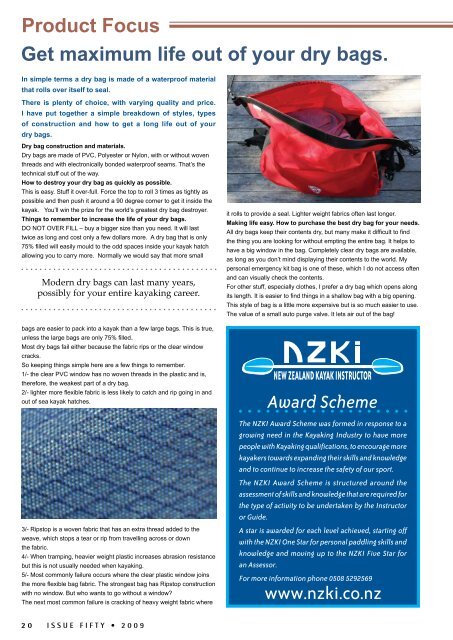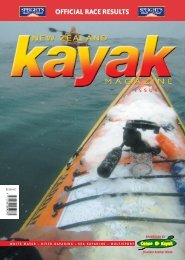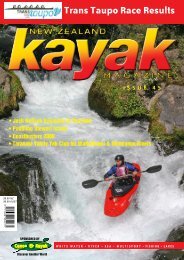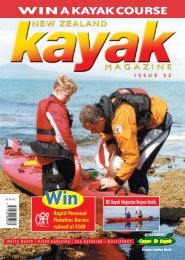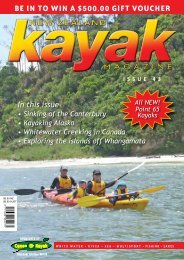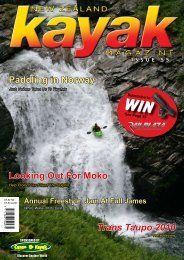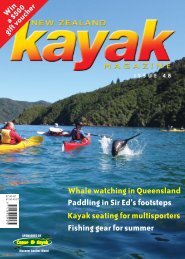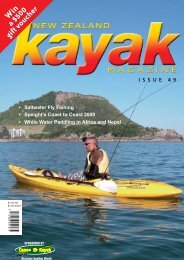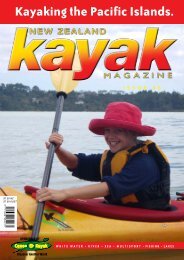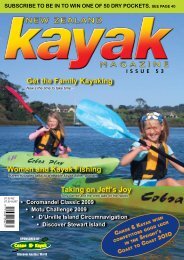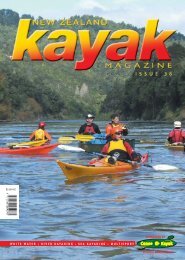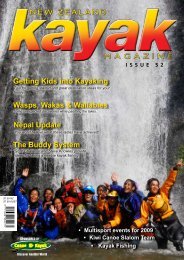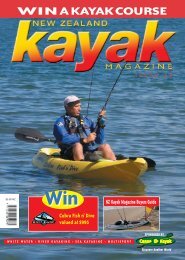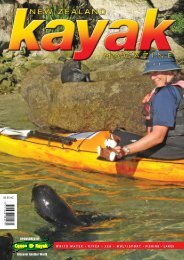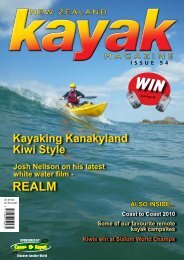Paddling Antarctica Be prepared! Speights Coast ... - Canoe & Kayak
Paddling Antarctica Be prepared! Speights Coast ... - Canoe & Kayak
Paddling Antarctica Be prepared! Speights Coast ... - Canoe & Kayak
Create successful ePaper yourself
Turn your PDF publications into a flip-book with our unique Google optimized e-Paper software.
Product Focus<br />
Get maximum life out of your dry bags.<br />
In simple terms a dry bag is made of a waterproof material<br />
that rolls over itself to seal.<br />
There is plenty of choice, with varying quality and price.<br />
I have put together a simple breakdown of styles, types<br />
of construction and how to get a long life out of your<br />
dry bags.<br />
Dry bag construction and materials.<br />
Dry bags are made of PVC, Polyester or Nylon, with or without woven<br />
threads and with electronically bonded waterproof seams. That’s the<br />
technical stuff out of the way.<br />
How to destroy your dry bag as quickly as possible.<br />
This is easy. Stuff it over-full. Force the top to roll 3 times as tightly as<br />
possible and then push it around a 90 degree corner to get it inside the<br />
kayak. You’ll win the prize for the world’s greatest dry bag destroyer.<br />
Things to remember to increase the life of your dry bags.<br />
DO NOT OVER FILL – buy a bigger size than you need. It will last<br />
twice as long and cost only a few dollars more. A dry bag that is only<br />
75% filled will easily mould to the odd spaces inside your kayak hatch<br />
allowing you to carry more. Normally we would say that more small<br />
Modern dry bags can last many years,<br />
possibly for your entire kayaking career.<br />
bags are easier to pack into a kayak than a few large bags. This is true,<br />
unless the large bags are only 75% filled.<br />
Most dry bags fail either because the fabric rips or the clear window<br />
cracks.<br />
So keeping things simple here are a few things to remember.<br />
1/- the clear PVC window has no woven threads in the plastic and is,<br />
therefore, the weakest part of a dry bag.<br />
2/- lighter more flexible fabric is less likely to catch and rip going in and<br />
out of sea kayak hatches.<br />
3/- Ripstop is a woven fabric that has an extra thread added to the<br />
weave, which stops a tear or rip from travelling across or down<br />
the fabric.<br />
4/- When tramping, heavier weight plastic increases abrasion resistance<br />
but this is not usually needed when kayaking.<br />
5/- Most commonly failure occurs where the clear plastic window joins<br />
the more flexible bag fabric. The strongest bag has Ripstop construction<br />
with no window. But who wants to go without a window?<br />
The next most common failure is cracking of heavy weight fabric where<br />
it rolls to provide a seal. Lighter weight fabrics often last longer.<br />
Making life easy. How to purchase the best dry bag for your needs.<br />
All dry bags keep their contents dry, but many make it difficult to find<br />
the thing you are looking for without empting the entire bag. It helps to<br />
have a big window in the bag. Completely clear dry bags are available,<br />
as long as you don’t mind displaying their contents to the world. My<br />
personal emergency kit bag is one of these, which I do not access often<br />
and can visually check the contents.<br />
For other stuff, especially clothes, I prefer a dry bag which opens along<br />
its length. It is easier to find things in a shallow bag with a big opening.<br />
This style of bag is a little more expensive but is so much easier to use.<br />
The value of a small auto purge valve. It lets air out of the bag!<br />
Award Scheme<br />
The NZKI Award Scheme was formed in response to a<br />
growing need in the <strong>Kayak</strong>ing Industry to have more<br />
people with <strong>Kayak</strong>ing qualifications, to encourage more<br />
kayakers towards expanding their skills and knowledge<br />
and to continue to increase the safety of our sport.<br />
The NZKI Award Scheme is structured around the<br />
assessment of skills and knowledge that are required for<br />
the type of activity to be undertaken by the Instructor<br />
or Guide.<br />
A star is awarded for each level achieved, starting off<br />
with the NZKI One Star for personal paddling skills and<br />
knowledge and moving up to the NZKI Five Star for<br />
an Assessor.<br />
For more information phone 0508 5292569<br />
www.nzki.co.nz<br />
20 I S S U E F I F T Y • 2 0 0 9


